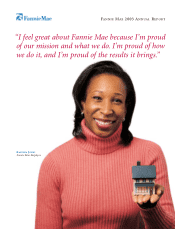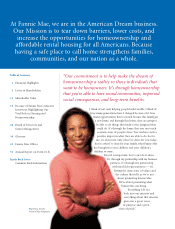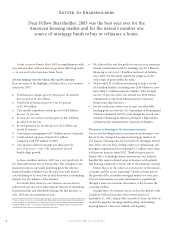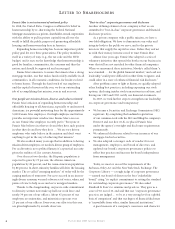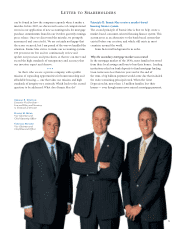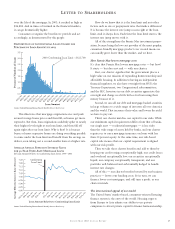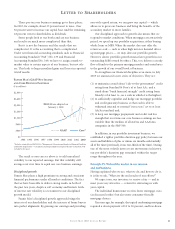Fannie Mae 2003 Annual Report Download - page 5
Download and view the complete annual report
Please find page 5 of the 2003 Fannie Mae annual report below. You can navigate through the pages in the report by either clicking on the pages listed below, or by using the keyword search tool below to find specific information within the annual report.
FRANKLIN D. RAINES
Chairman and
Chief Executive Officer
3
LETTER TO SHAREHOLDERS
Over the past few years, when workers faced massive layoffs,
and the U.S. financial markets lost much of their value, housing
not only survived the recession, it softened its effect. Housing
construction stayed strong, offsetting job losses in other sectors.
Families were able to access the wealth in their homes to see
themselves through tough times, which boosted consumer
spending and supported the economy.
Consumers were able to cut hundreds of dollars from their
monthly payments and lock into the cheapest mortgage
money we have seen in decades. They also readjusted their
personal balance sheets by cashing out some of the home
equity wealth they built up as the value of their homes
increased to pay down other higher cost debt.
Since the beginning of 2000, the residential mortgage market
(measured by total residential mortgage debt outstanding) has
expanded by over 50 percent. At the same time, homeowners
have gained $2.6 trillion in home equity wealth — a gain that
helped to offset the $3.2 trillion equity loss in the stock market.
In 2003 alone, homeowners tapped into about $130 billion of
their home equity wealth. They plowed 60 percent of it —
about $80 billion — back into the economy by fixing up their
homes and spending on other goods and services.
What has made this massive refinance boom possible? The
secondary mortgage market in America and its power to provide
low-cost housing finance to consumers in all places, at all
times, under all economic circumstances. Everyone involved in
Fannie Mae’s success — including you — should be justly proud
of this accomplishment, helping put the power of housing to
work for both homeowners and the American economy.
The First Principles of Fannie Mae and our mission
Given Fannie Mae’s unique role in the U.S. housing sector, the
mortgage industry, the financial markets, and in the plans of
American home buyers, it is important for us to return from
time to time to what I call the First Principles of Fannie Mae:
to describe to the world who we are, what we do, how we do
it, what are the results, and why they are important — to you
and to the country.
This back-to-basics approach is particularly relevant and
useful right now as Congress considers legislation to strengthen
the financial regulator of Fannie Mae and our competitors,
Freddie Mac and the Federal Home Loan Banks.
Fannie Mae has made clear that we support having a strong,
credible, well-funded regulator because it is in the best interests
of housing, home buyers, and our company. At this writing,
Congress is still working on legislation. I believe any remaining
issues regarding our new regulator are bridgeable. I also believe
that the best way to build that bridge (and avoid harmful
unintended consequences) is to make sure that all of us —
investors, regulators, legislators, and employees — have a
sound understanding of the fundamentals of the secondary
mortgage market.
My goal is to give you, our investors, a greater understanding
of the Fannie Mae investment proposition — and to give
you a framework for understanding — and explaining — the
Fannie Mae public policy proposition.
Principle I: Fannie Mae is a private company
with a public mission
Fannie Mae is a purpose-driven company. All that we are, all
that we do, and all that we seek to become revolves around
an elementary proposition: that owning a home is a defining
element of the American Dream.

